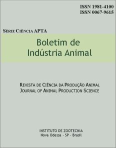Lysine levels for pigs in the growing initial-I phase, performance and nitrogen retention
Keywords:
feed/gain, nitrogen balance, piglets, weight gainAbstract
Two experiments were effected for to determine the best lysine level for pigs from 6,00 to 11.60kg of live weight. In the first (performance) it was utilized 100 piglets with weight 5.96±0.52kg and in the second (metabolism) 25 piglets with weight 10.80±1.40kg of live weight. The experimental design used was in complete randomized blocks with five treatments and five replications. The experimental units were constituted by four animals in the experiment 1 and one animal in the experiment 2. The treatments were lysine levels (0.85; 0.95; 1.05; 1.15 e 1.25%). There was linear effect increasing live weight gain and reducing the feed/gain as lysine levels increased in diets. The results of performance indicated a higher eficiency of utilization of dietetic lysine with increasing levels. The same effect was observed in the nitrogen retention, in response to increased lysine levels, characterizing a better arrangement in aminoacids balance for the protein synthesis. The Linear Response Plateau model did not adjust the variables. The responses observed indicated that requirement of levels not lower than 1.25% of lysine for piglets from 6 to 11kg. Considering the linear effect obtained in the evaluated characteristics should be recommended that the optimum lysine level be above 1.25%.
Downloads
Downloads
Published
Issue
Section
License
Os autores não serão remunerados pela publicação de trabalhos, pois devem abrir mão de seus direitos autorais em favor deste periódico. Por outro lado, os autores ficam autorizados a publicar seus artigos, simultaneamente, em repositórios da instituição de sua origem, desde que citada a fonte da publicação original seja Boletim de Indústria Animal. A revista se reserva o direito de efetuar, nos originais, alterações de ordem normativa, ortográfica e gramatical, com vistas a manter o padrão culto da língua e a credibilidade do veículo. Respeitará, no entanto, o estilo de escrever dos autores. Alterações, correções ou sugestões de ordem conceitual serão encaminhadas aos autores, quando necessário. Nesses casos, os artigos, depois de adequados, deverão ser submetidos a nova apreciação. As opiniões emitidas pelos autores dos artigos são de sua exclusiva responsabilidade. Todo o conteúdo deste periódico, exceto onde está identificado, está licenciado sob a Licença Creative Commons Attribution (CC-BY-NC). A condição BY implica que os licenciados podem copiar, distribuir, exibir e executar a obra e fazer trabalhos derivados com base em que só se dão o autor ou licenciante os créditos na forma especificada por estes. A cláusula NC significa que os licenciados podem copiar, distribuir, exibir e executar a obra e fazer trabalhos derivados com base apenas para fins não comerciais.













